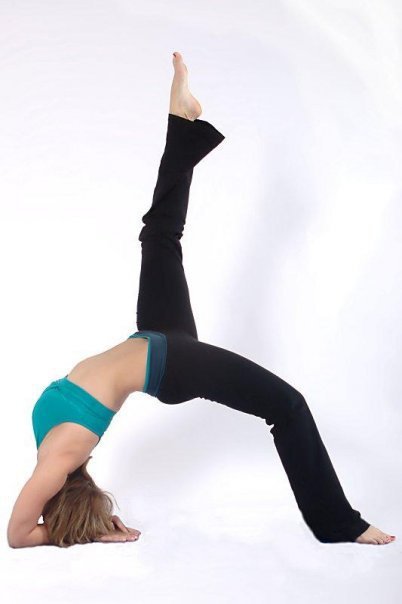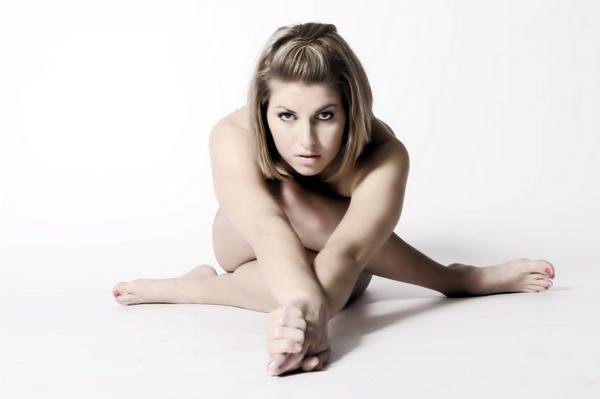Guest Post By Lindsey Freeman
 Yoga – Yoga (Sanskrit, Pāli: yoga) is commonly known as a generic term for a physical, mental, and spiritual discipline originating in ancient India[1][2] and found in Hinduism, Buddhism, Jainism
Yoga – Yoga (Sanskrit, Pāli: yoga) is commonly known as a generic term for a physical, mental, and spiritual discipline originating in ancient India[1][2] and found in Hinduism, Buddhism, Jainism
My very first yoga class was the summer after I graduated high school. I always had a strong curiosity about the yoga practice but didn’t really know much about it. Being from the south, Yoga wasn’t practiced much in my area. I had difficulties finding a legitimate place to check it out; unfortunately it just wasn’t readily available.
The opportunity arose when the local gym I had a part time job at, started providing classes. After my first class I was immediately hooked. It was so much different than anything I had ever tried. I was challenged physically AND mentally.
As time went by my life took me to Tuscaloosa, AL as an enrolled student at the University of Alabama. I wanted a part time job while I was there so I opted to attend a yoga instructor training course. After gaining my Yoga I certification through YogaFit, I applied for a yoga teaching position to the university’s fitness center. And much to my surprise, they hired me immediately.
My first couple classes were shaky… I had cheat sheets with drawn stick figures of all the moves, and I frequently messed up the names of the poses. But gradually instructing became easier and my confidence level in my teaching grew to the point where I could practically teach it in my sleep. I truly loved it there. I had a great group of people who were loyal to my class. It was such a wonderful experience for my first year of teaching.
After a year at UA I decided to move back home. I wanted to keep my yoga practice going after my move, so I applied to various local gyms. I received a substitute job for a few different gyms. The classes were random and sometimes conflicted with my school schedule so it was hard to really get in tune with the facility and students. At one of the gyms I taught the class was mostly elderly women, and no matter what I did they were not pleased. It was so disheartening and frustrating. After a few more discouraging classes I finally decided to resign my position as the yoga “substitute.” I never felt so relieved. That experience ruined yoga for me for quite some time…
After that experience I was presented with many other opportunities to teach. It wasn’t until a fellow instructor asked me to join her at a new gym. Not sure why, but I accepted. I taught there for over a year and regained my love for yoga. I even went back for more training and expanded my class to even some Pilates moves. My classes were fun and I had best friends who participated in almost every class!
I have now moved on from teaching but I still love practicing. The new area I live in these days has infinite choices of yoga studios to choose from. For those of you who are interested and want to check yoga out for yourself I encourage you to do some research in your area to see what is offered. There are so many different styles and unique forms of this ancient practice. There is virtually something out there for everyone! So don’t be afraid to try it out, yoga is noncompetitive and every yogi has to start somewhere. Namaste’
Below is a “Yoga Quick Guide” I found useful to the Yoga beginner. (Credit Lululemon.com)

Yoga Quick Guide:
- Antigravity: Fluid, acrobatic yoga… in a hammock.
- Anusara: Playful. Expect to laugh and go upside down.
- Ashtanga: Athletic and vigorous.
- Bikrams: Consistent poses in a very heated studio.
- Hatha: Foundation for many yoga styles. Great for beginners.
- Hot: Make sure to bring a towel — or two!
- Iyengar: With a focus on structure, usually uses blocks, straps for support.
- Kundalini: Focused on meditation and breathing.
- Power/Flow/Vinyasa: An athletic and physically challenging style.
- Pre- and Post-natal: Gentle Hatha yoga is ideal for pregnant women to help lower stress.
- Yin: A slow class that will take you deeper than you’ve ever gone.
Here’s the extended version of each style mentioned above:
antigravity
It’s easy to free your mind when a hammock is gently cradling you and gravity does the work of deepening your stretch. The compression-free inversions can be terrifying at first until you realize that the hammock has your back. Antigravity yoga is all about trust. Trust and the blissful sensation that you’re floating.
anusara
Expect a playful class with a strong focus on proper alignment and Tantric yoga philosophy (not what you’re thinking). It (like most yoga) is derived from Hatha yoga.
ashtanga
This practice is very athletic and made up of six vigorous series of postures. It’s one of the oldest forms of yoga and is considered to be the foundation of much of the yoga we see today in the west.
bikram
You’re going to sweat in a Bikram’s class, more than you ever thought was possible. Bikram yoga consists of 26 postures and breathing exercises repeated twice (that’s right 90 minutes) in a room heated to 105 degrees. Heads up – humidity is 40% and will knock you over the first time.
hatha
The foundation of every style of yoga mentioned here. Traditional Hatha yoga is a holistic path that includes disciplines, physical postures (asana), purification procedures, breathing (pranayama), and meditation. Hatha practiced in the West consists of mostly physical postures and is also recognized as a gentle introductory yoga for people new to yoga.
hot
By adding heat it is said that classes will help you lose weight, loosen your muscles (by adding increased range of motion) and improve your cardiovascular system. It differs from Bikram’s in that the series of postures are not always (but can be) in any particular order and modifications are often offered.
iyengar/restorative
Expect a class emphasizing healing the body and mind through use of supported postures. One of the oldest forms of yoga, it’s for a person who loves technical intricacies and is also great for people who are new to yoga or have any issues with their health.
kundalini
Don’t be surprised if your waving your hands like you just don’t care or laughing uncontrollably, this practice is intended to wake up the kundalini energy coiled at the base of your spine while activating chakras (energetic centers in the body), as well as detox the body and mind.
power
Many say Power yoga is the Western interpretation of Ashtanga. It is sometimes done in a heated room and focuses on the breath as fuel for the practice. This practice can be challenging for beginners, but is a nice balance to more gentle forms of yoga once you become comfortable with the different postures.
vinyasa/flow
Derived from Ashtanga yoga, expect a class full of rhythmical flow (often combined with music) connecting each moment with unifying pranayama (breath). Classes can be more meditative or focused on the natural movement of the body, almost like dancing through postures. A great transition from Hatha when you’re looking for more of a challenge.
yin
Some believe that Yin yoga is the oldest form of Hatha yoga, since it is the ideal method of physical conditioning for prolonged meditation. Don’t let the props and gentle movement fool you, this is not a form of restorative yoga. The long holds require that you focus and release all effort from the muscles.
Speak Your Mind